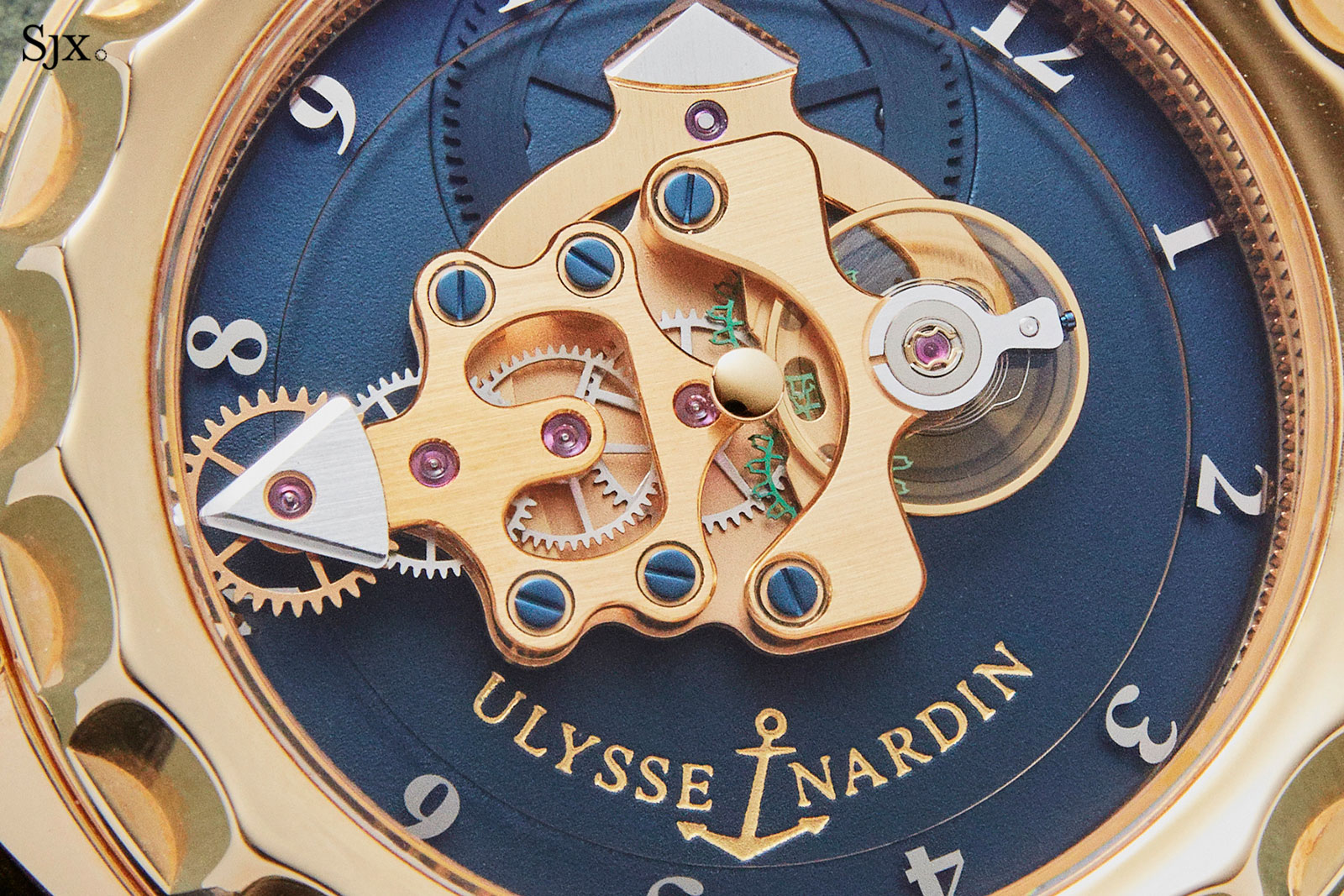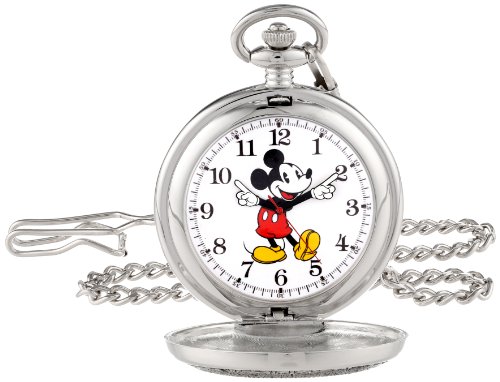
Novel methods of telling the time or exhibiting the motion have lengthy been the main target of the avant-garde horologists. Impartial watchmakers like Ressence or Urwerk have constructed their manufacturers on putting off typical palms. Such idiosyncratic approaches to watchmaking problem the traditions of horology, making for a extra attention-grabbing horological panorama.
However properly earlier than Urwerk got here onto the scene, there was the Ulysse Nardin Freak. Launched in 2001, the Freak actually modified the face of watchmaking by transposing the motion into the dial. 20 years after its launch, the Freak continues to be thought to be a landmark for its audacity, from each aesthetic and technical perspective.
The origins
The start of the Freak lay in 1997, when Carole Forestier-Kasapi, then a younger and proficient motion designer who solely just lately graduated from technical school, gained the Prix de la Fondation Abraham-Louis Breguet, a contest conceived to mark A.-L. Breguet’s 250th birthday that sought to recognise watchmaking ingenuity.
Now the top of motion growth at TAG Heuer, Ms Forestier-Kasapi claimed the prize with an idea that featured a revolving motion containing a mainspring enclosed in a donut-like barrel nearly as vast because the case. Seated throughout the barrel was the gear prepare and regulator. The idea watch had no crown, with the setting and winding completed by turning the bezel.
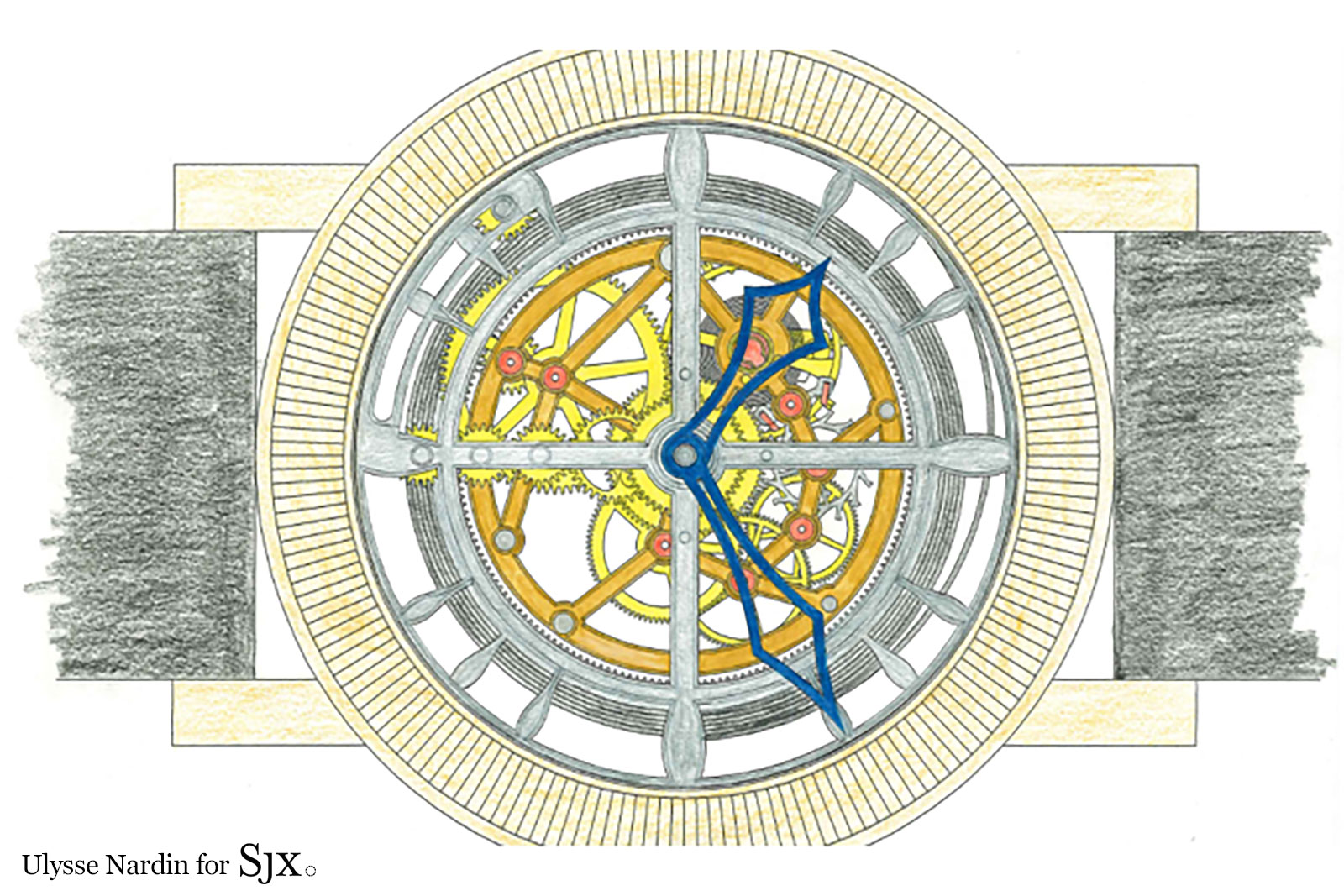
The unique drawing for the Freak Idea by Carol Forestier-Kasapi. Picture – Ulysse Nardin
After successful the prize, Ms Forestier-Kasapi then joined Ulysse Nardin, a once-illustrious agency well-known for its marine chronometers that was laid low by the Quartz Disaster. Led by its then proprietor, the visionary Rolf Schnyder, the agency launched into a comeback beginning within the late Eighties, propelled in giant by its sensible technical director, Dr Ludwig Oechslin.
That interval noticed Ulysse Nardin launch the Trilogy of Time sequence of astronomical issues – which gained a spot within the Guinness Guide of Information in 1989 as essentially the most sophisticated watches in manufacturing – and the intelligent Perpetual Ludwig, a perpetual calendar that might be set backwards and forwards.
Consistent with the model’s innovation-driven method to merchandise on the time, Schnyder confirmed nice curiosity in remodeling Ms Forestier-Kasapi’s prize-winning idea right into a serially-produced watch. Unsurprisingly, commercialising the novel idea rapidly bumped into problem.
The creative donut-like mainspring barrel was not sensible because it imposed limits on the scale of the mainspring, which meant it may solely energy the energy-hungry motion for under about 15 hours on a full wind. This prompted a rethinking of the concept proper all the way down to its fundamentals.
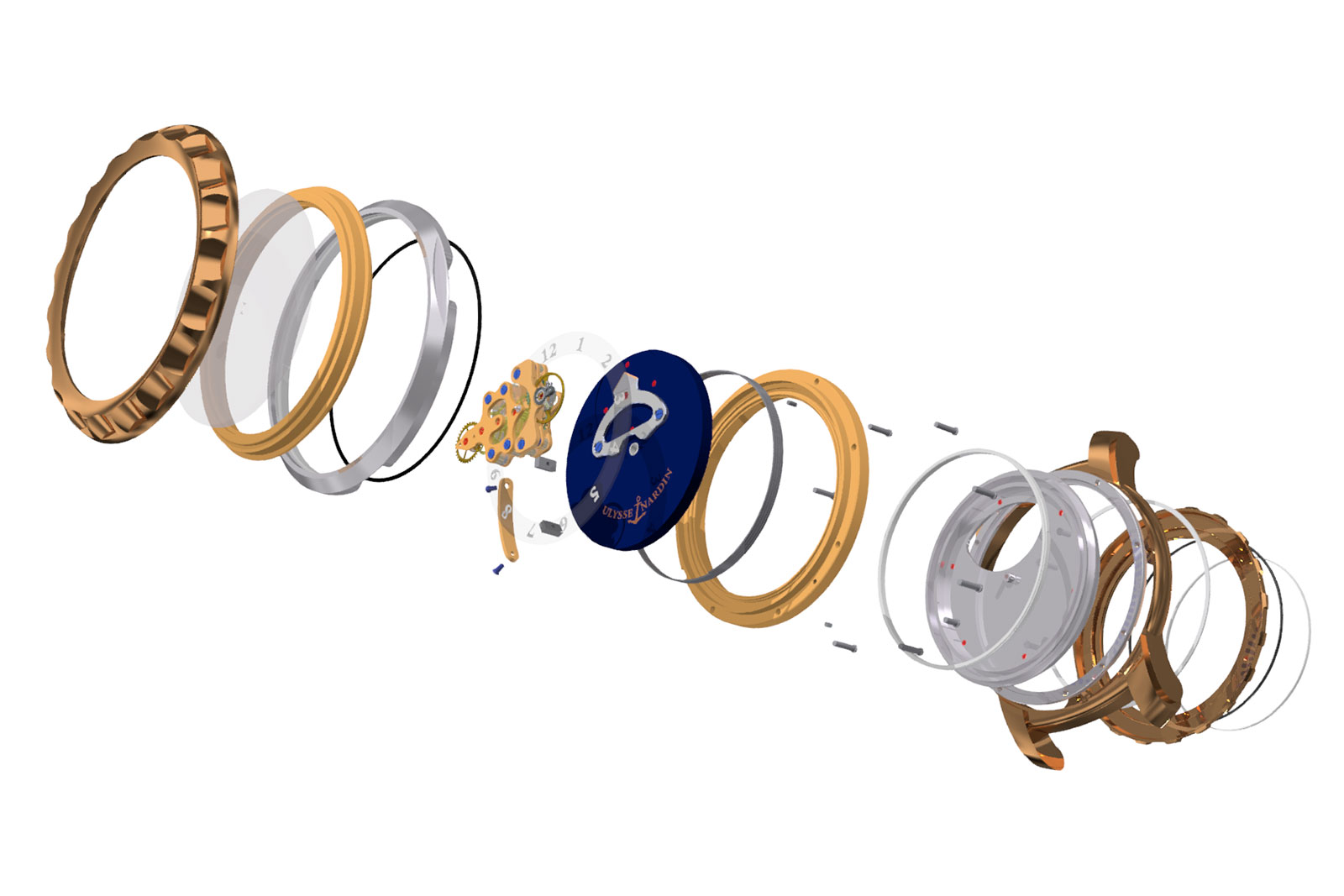
Exploded view of the 2001 Freak. Picture – Ulysse Nardin
Tasked with making the revolving-movement watch possible, Dr. Oechslin drastically altered the method to create a motion that continues to be distinctive to this present day. With an eclectic training – together with levels in archaeology, historical historical past, theoretical physics, and philosophy – and hands-on expertise with horological restoration, Dr Oechslin is a rarity in watchmaking as polymath in a position to sort out demanding issues in radical methods.
Regardless of its completely unorthodox development, the Freak is illustrative of Dr Oechslin’s philosophy, one that always employs creative use of gearings and utilized arithmetic, an method nearer to a mathematician’s workings fairly than a watchmaker’s engineering.
The fundamental rules
Ms Forestier-Kasapi’s unique development was unsuited to giant scale manufacturing. The design was energy-intensive in operation however had little house for a mainspring giant sufficient to energy the motion for an inexpensive size of time. In her design, the mainspring needed to match inside throughout the donut-shaped hub between the motion and case.
After taking on the event of the watch, Dr Oechslin rethought the idea, most famously putting in the massive mainspring beneath the motion. The barrel was not merely relocated, however was essentially reworked to remodel it into an energetic element of the time show.
The Freak’s trademark function was all the time the best way it tells the time, with the going prepare doubling as an outsized minute hand, whereas the barrel cowl capabilities because the hour hand. Intriguing and putting on the identical time, the movement-as-hands development might sound way more complicated than a traditional motion. Surprisingly, this isn’t the case – and now we’ll see why.
The hour hand
The primary prototype created by Dr Oechslin already the entire components that outlined the following manufacturing mannequin. A big coiled mainspring is seen by means of the cut-outs within the base plate, which is definitely the barrel cowl.
Regardless of its uncommon dimension and placement, the barrel is nearly similar to an everyday barrel in kind and performance, being basically drum containing an extended spring coiled round a central arbour. The outer finish of the mainspring connects to the barrel’s partitions whereas the innermost finish connects to the arbour.
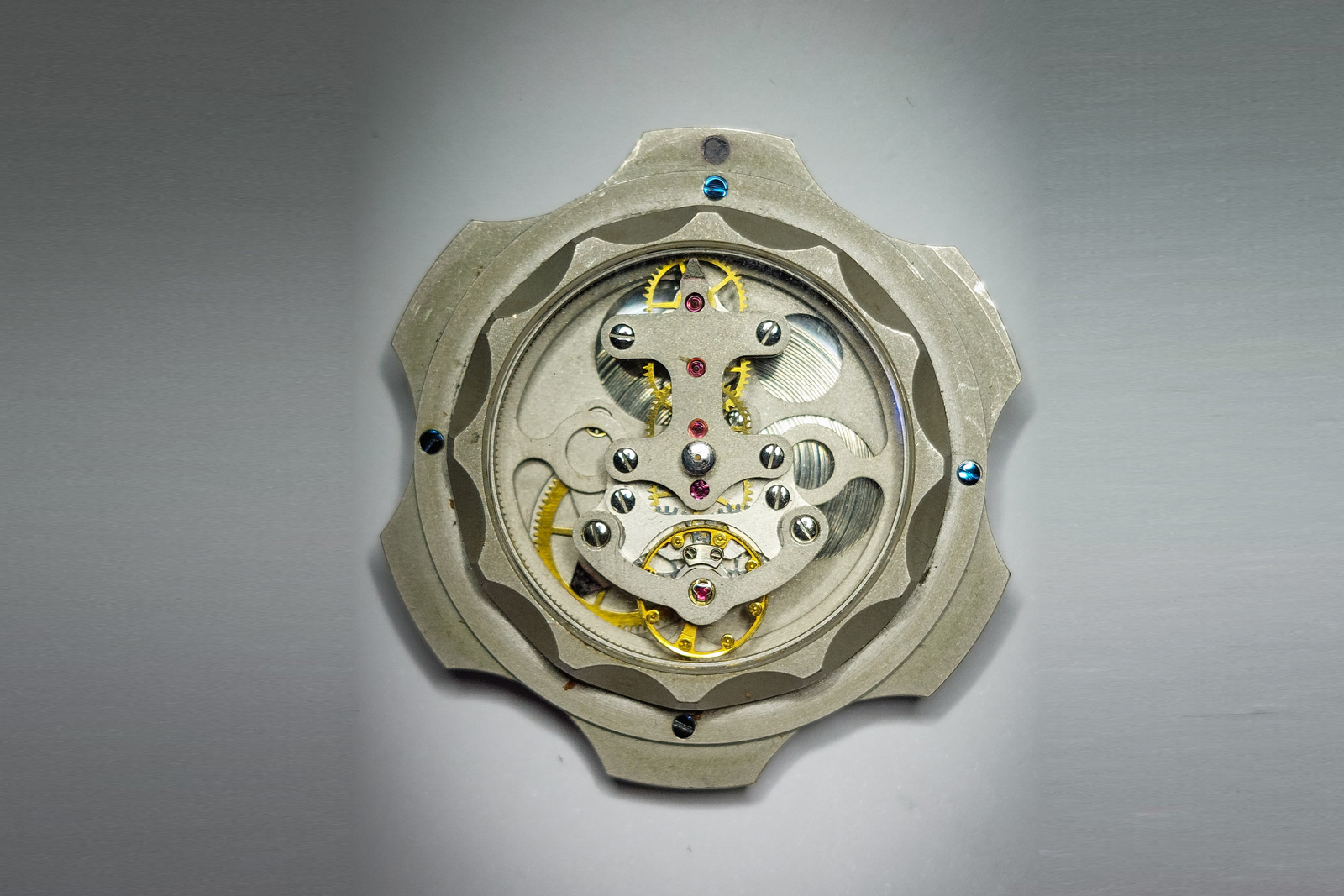
The primary Freak prototype constructed by Ludwig Oechslin. Picture – Ulysse Nardin
Functionally, the barrel of the Freak additionally operates on the identical rules as a traditional barrel. Because the arbour is turned when winding the watch, the coils of the spring tighten, storing potential elastic vitality. As soon as totally coiled, the spring begins to rotate the barrel in the other way as its outer coil pulls the barrel alongside because the spring unwinds.
Standard barrels function a toothed rim on the surface of the barrel that engages with the second wheel of the going prepare (the barrel serves as the primary wheel of the gear prepare).
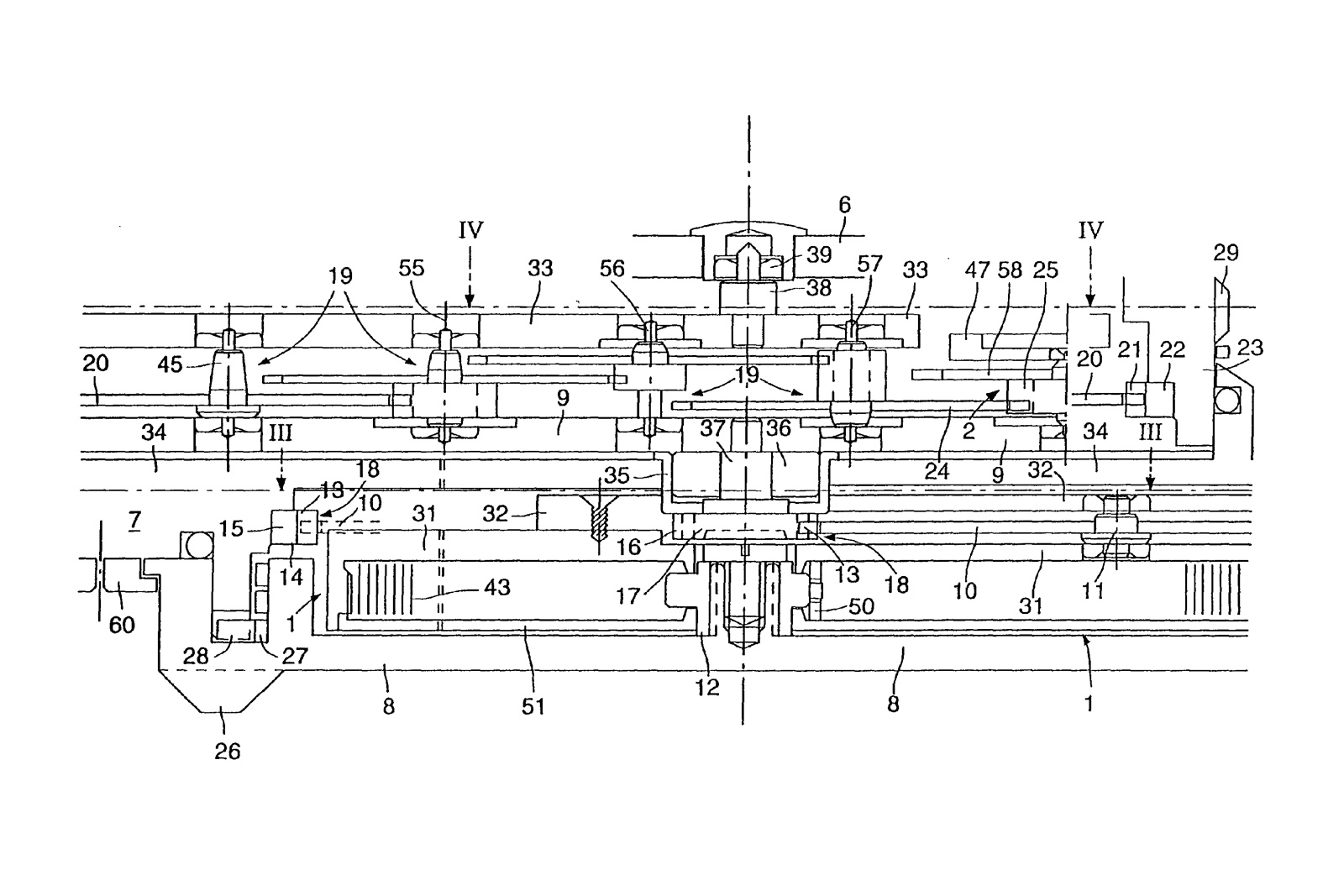
Fig. 1
The barrel development of the Freak depends on complicated gearing to attain a easy, helpful objective: a rotation ratio of 12 between the hour and minute palms. So as phrases, the minute palms makes 12 revolutions across the dial in the identical time the hour hand completes one revolution. Right here, we clarify how that’s completed.
The Freak’s giant barrel sits very low within the case and doesn’t function any tooth on its rim. As seen within the sectional diagram in fig. 1, the arbour is rigidly joined with a beneficiant click on wheel, which works with a pair of clicks to restrict the arbor’s rotation to 1 path solely. The clicking wheel is instantly linked to the timepiece’s case again.
By development, the case again is free to pivot on ball bearings, in for the wearer to wind the watch by rotating the again within the correct path. The mainspring is about in such manner that it drives the barrel in a clockwise path when unwinding, when seen from the dial. It is very important notice that the barrel is free to totally flip contained in the case.
The mainspring is of unusually lengthy size and substantial thickness, making it a robust motor for the motion. Resulting from its monumental dimension, manually winding the mainspring with a conventionally-sized crown could be tedious and bordering on the unimaginable. Winding the spring instantly by means of the big diameter case again is way more handy, with elevated grip and leverage each work in favour of the person.
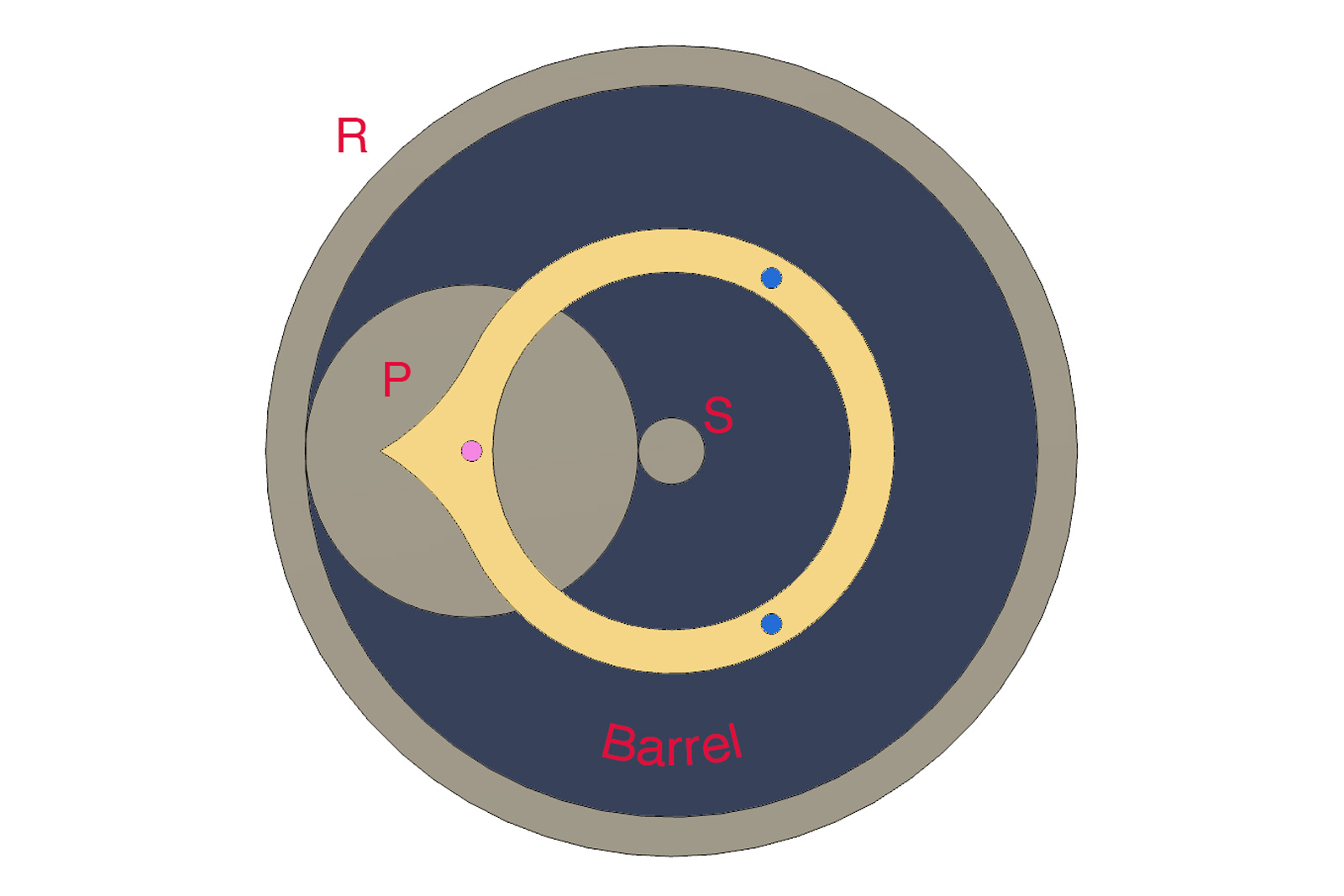
Fig. 2
At its core, the Freak is a realisation of planetary gearing. Planetary, or epicyclic, gears have many makes use of in very numerous fields of mechanical engineering attributable to some helpful proprieties. For instance, automotive transmissions and gearboxes normally implement numerous planetary gears.
In watchmaking, planetary gears are typically used for energy reserve indicators. Within the Freak’s case, the planetary gear takes centre stage. Each primary planetary gear set contains of a hoop gear (marked R in fig. 2), a planet gear (marked P), a service (the blue barrel cowl on this occasion) that carries the planet gear, and lastly a solar gear (marked S).
Though they share the identical axis, wheel S turns independently from the service (barrel), so the latter’s motion doesn’t instantly affect the previous. Gear P securely pivots between the barrel and the bejewelled gold bridge/ hour indicator. It engages with each S and the inner toothing of the ring R.
Whereas P and S are free to maneuver, ring R is rigidly joined to the case, remaining stationary. As said, beneath the pressure of the mainspring, the barrel tends to spin in a clockwise method.
As soon as the barrel is wound and begins transferring. Wheel P, carried by the barrel and its affixed bridge, turns round its axis dragged towards the stationary inner toothing of R. In flip, this engages S in rotation round its personal axis, however at a unique angular velocity in comparison with the barrel.
It could be troublesome at first to find out the transmission ratios from one gear to a different, since this isn’t a traditional gear prepare. However because the association kinds a basic planetary set, the Willis equation for planetary gears will be utilized.
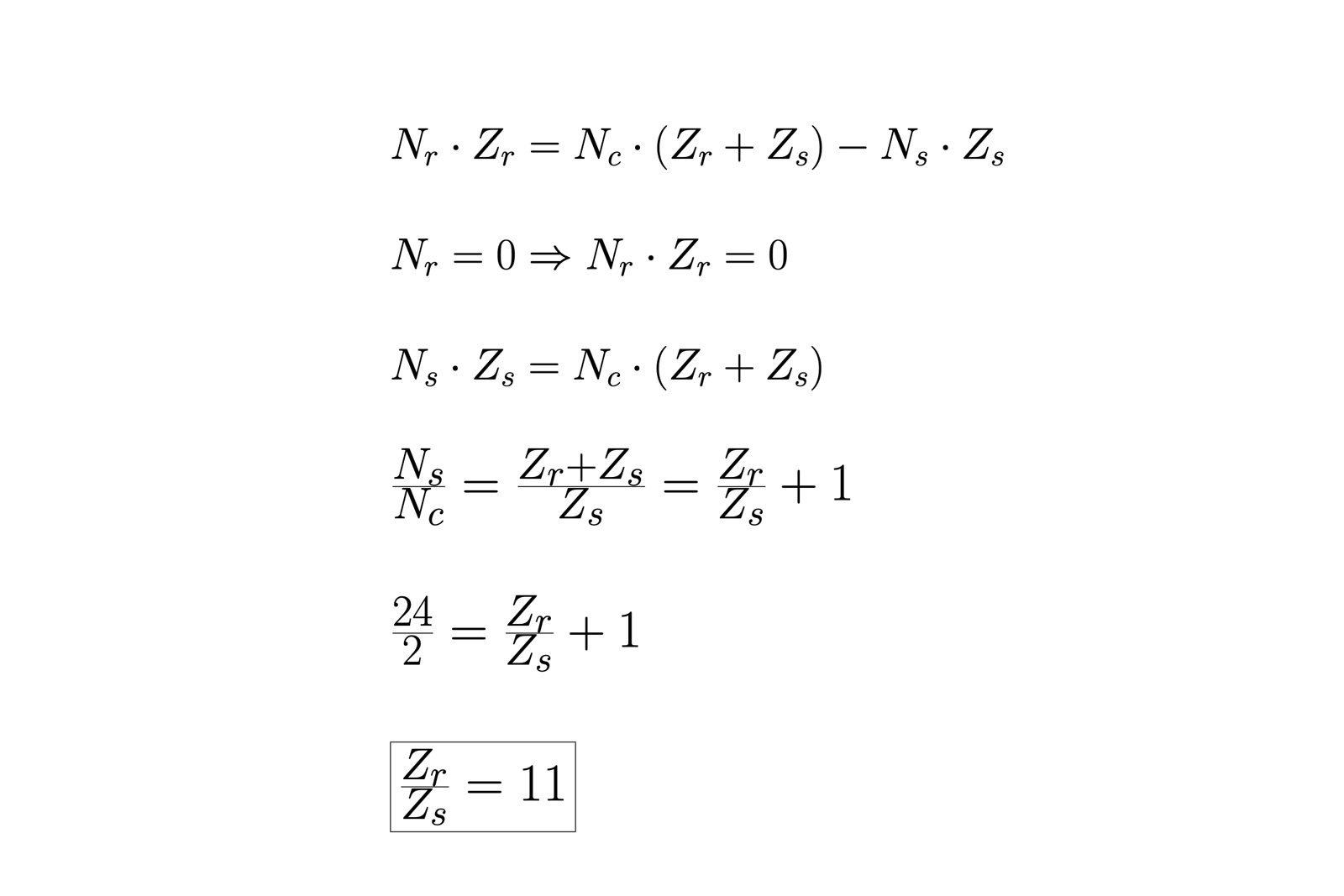
Fig. 3
The basic equation of planetary gears, also referred to as the Willis equation, is a really helpful mathematical expression that describes the movement of particular person elements in a planetary gear.
Fig. 3 reveals firstly the overall type of the equation, with the next conventions: Nr is the variety of revolutions per day of the ring gear, Nc is that of the service and eventually Ns is that of the solar gear; Zr and Zs are the numbers of tooth for the ring and solar gears, respectively.
Within the case of the Freak, the ring R is mounted, thus stationary, so its variety of every day revolutions Nr have to be zero. The variety of every day revolutions of the service Nc is 2, as a result of it doubles as an hours indicator that goes across the dial twice a day. The solar gear S carries the minute hand/secondary gear prepare, which implies it makes 24 revolutions across the dial every day, one revolution per hour, so Ns is 24.
By subtracting the determine from our equation and after some subsequent simplifications, we’re left with the helpful ratio between the variety of tooth of the ring and solar gears. Widespread to most Freak fashions, 16 is the variety of tooth for S, which means 176 tooth for the ring R, in line with the ratio discovered above. On this method, the barrel turns as soon as for each 12 revolutions of the solar gear, precisely the standard ratio between the hour and minute palms.
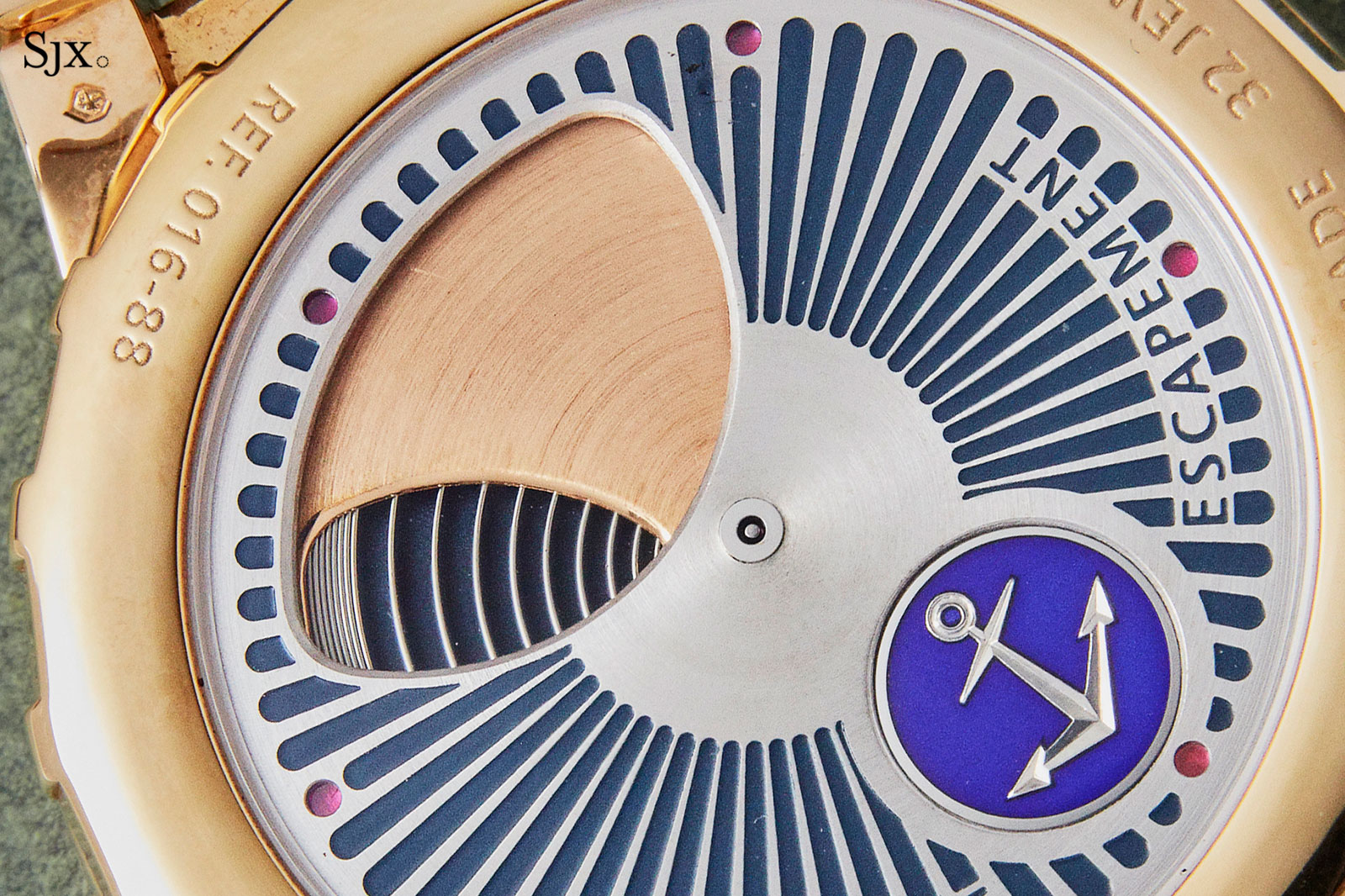
The case again of the unique Freak revealing the barrel inside and the coils of the mainspring
The minute hand
The rate ratio between the hour indicator and centre pinion has been established above, leaving solely the necessity to regulate the discharge of energy from the barrel because the mainspring unwinds. That is finished in a reasonably typical manner, utilizing a sprung regulator and a set of going gears, very very like an peculiar motion.
The centre pinion S is bigger than regular to hold the minute hand platform. The platform, in flip carries a going prepare, which is specified by an identical method as classical constructions.
The strategy of energy switch, nevertheless, is unusual, because the barrel doesn’t instantly have interaction with the going prepare. As an alternative, the going prepare engages at one finish with an inside ring gear. This inside gear is just nearly stationary, in contrast to the R element within the planetary meeting. It’s related to the watch case’s turning bezel, which permits the wearer to not directly act on the going prepare. However until it’s engaged from the bezel, the ring gear stays stationary.
As the bottom pinion turns, it carries the minute platform with it. Dragged alongside by the inside gear, the going prepare springs to life, finally participating the escapement and stability. Within the classical vogue, when the escapement is locked, your entire system, platform to mainspring, stops.
The stability frequency and gearing ratios are computed to conveniently permit the platform to totally flip as soon as each 60 minutes, enabling it to behave because the minute hand. The element gears are highlighted in fig 4. They bear a putting resemblance to classical going trains, which typically results in the conclusion your entire calibre is housed within the rotating platform. That is solely in partly true, as we’ve seen that the motion structure goes deeper than that.
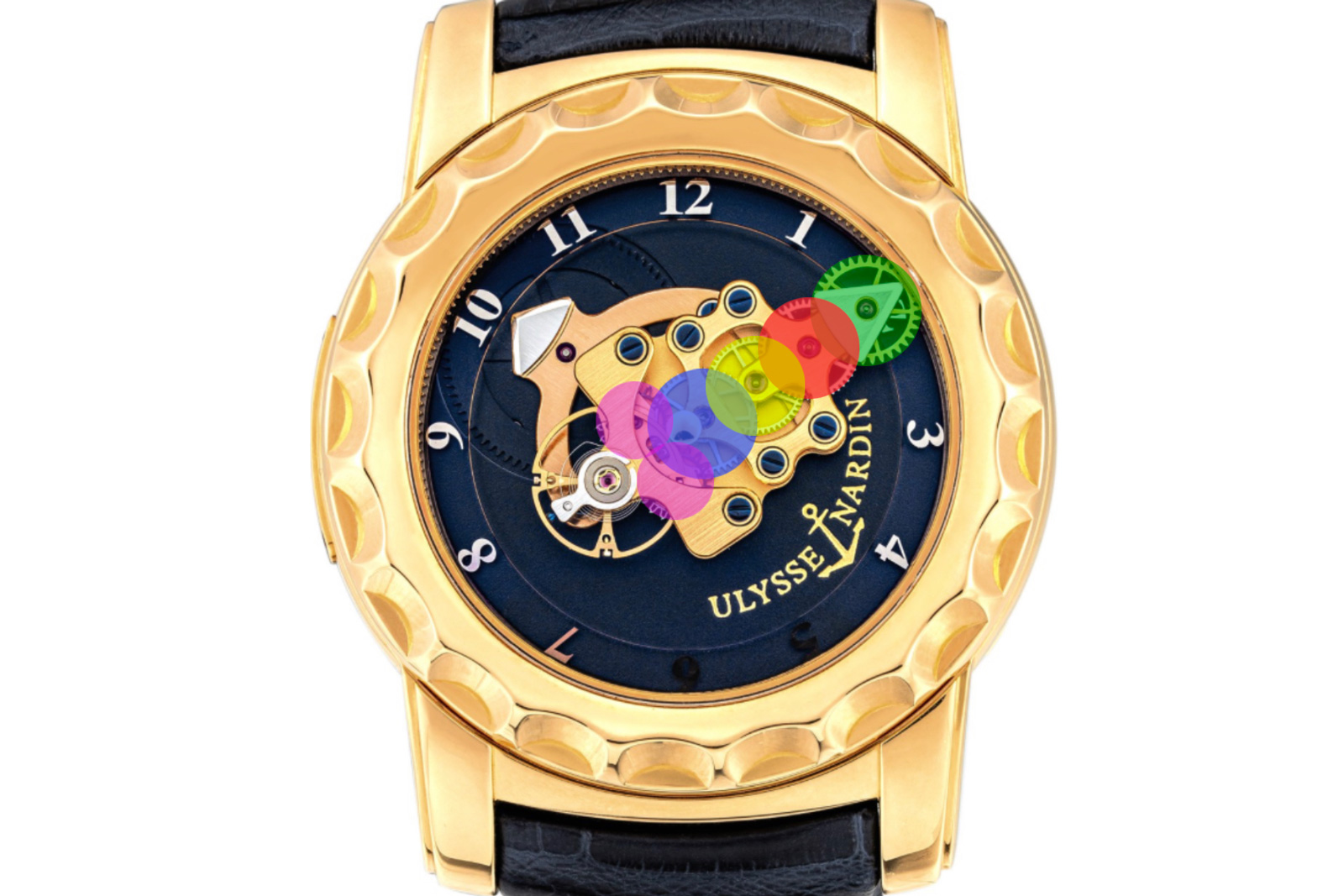
Fig. 4
The quirky time setting of the Freak is famously finished by turning the watch’s entrance bezel. Within the unique mannequin, the bezel had a wave-patterned edge resembling a bottle cap, a nod to Ulysse Nardin’s maritime heritage and a concession to utility.
As mentioned above, the inner ring gear participating the minute platform is instantly linked to the bezel. In principle, this could result in some issues. Turning the bezel ought to theoretically disrupt the ability move from the mainspring to the escapement. And setting the time implies transferring the minutes and hours palms towards the gears.
Because the hour indicator is mainly the barrel, setting the time and disrupting the barrel’s rotating movement would imply performing instantly on the mainspring. In that case, it stands to motive that setting the Freak clockwise ought to unwind the barrel, whereas setting it counter clockwise would wind it, imposing extra stress the mechanism.
The answer to that’s the implementation of a slipping bridle on the mainspring. Generally discovered it computerized actions, the bridle permits the mainspring to securely “slip” alongside the inside barrel partitions when totally coiled, whereas nonetheless exerting torque. That is finished to stop breakage of a completely wound mainspring at the same time as the automated mechanism continues to wind.
Within the Freak’s case, the implementation of the slipping bridle signifies that the barrel is allowed to show freely with out upsetting the mainspring inside, with a minimal lack of exerted torque.
Even with that in place, the Freak stability severely drops in amplitude throughout time adjustment, as the conventional torque move is disrupted and the escapement loses energy, however the impact on timekeeping is minimal because the time setting doesn’t take lengthy and the total energy move immediately resumes afterwards.
The unique 2001 Freak featured an nearly free-turning bezel, saved stationary solely by the friction of the sealing gaskets contained in the case. The wearer was free to regulate the time at any time, with out the necessity to have interaction a specific setting mode. In consequence, the bezel inclined to maneuver nearly by itself, because the mainspring stress was travelling instantly into the bezel’s inner ring, making it inclined to rotate on the slightest bump or brush towards one thing.
This was rectified in subsequent variations of the Freak, which all featured a hinged, locking tab on the base of the bezel. When the tab is engaged and sits flat on the case, it places strain on the bezel, forming a easy locking mechanism. Lifting the tab unlocks the bezel for time setting, an answer that was surprisingly easy and chic, but sensible.
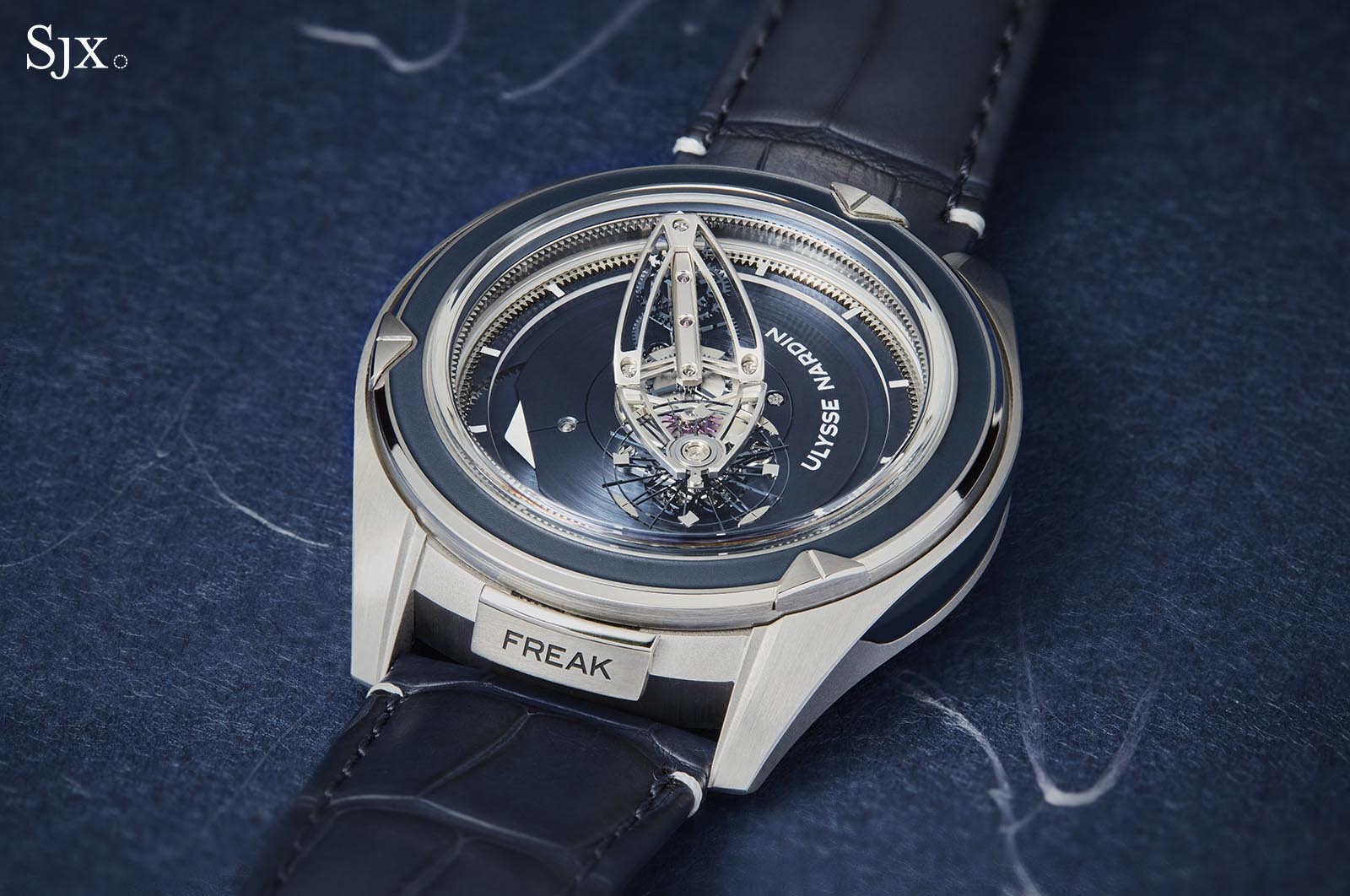
The locking tab additionally serves an ornamental operate since it may be engraved, as proven right here on the Freak Imaginative and prescient
Tourbillon or karrusel?
Pobably the quintessential invention of A.-L. Breguet, the tourbillon was invented to compensate for poising defects and subsequent positional fee errors. Breguet’s invention frequently rotated the oscillating organ round its personal axis, successfully cancelling the poising errors.
Impressed by the tourbillon, Bahne Bonniksen, a German horologist and inventor who settled in England, got down to adapt and enhance on Breguet’s idea, looking for to make it extra sturdy and cheaper to fabricate. The outcome was the karrusel, a novel kind of revolving meeting meant to maneuver the stability by means of all doable vertical positions. The karrusel was largely favoured by English makers like Charles Frodsham and Nicole Nielsen, however achieved neither the celebrity nor the status of the tourbillon.
Due to its revolving development, the Freak was lengthy thought-about both be a tourbillon or karrusel. However to find out whether it is both, we have to perceive the distinction between the 2.
There nonetheless persists confusion as to the variations between a tourbillon and karrusel. Each are contraptions that isolate the stability from the mounted predominant plate, turning it on a cage or platform.
Probably the most obvious distinction between the tourbillon and karrusel are their respective turning velocities: a tourbillon normally revolves as soon as a minute (in fashionable incarnations typically even quicker), whereas the karrusel turns a lot slower, normally over the course of 52.5 minutes (as suggested within the unique 1894 patent by Bonniksen). The motion of the tourbillon seems extra vigorous and interesting, whereas the karrusel strikes as gradual as an hour hand.
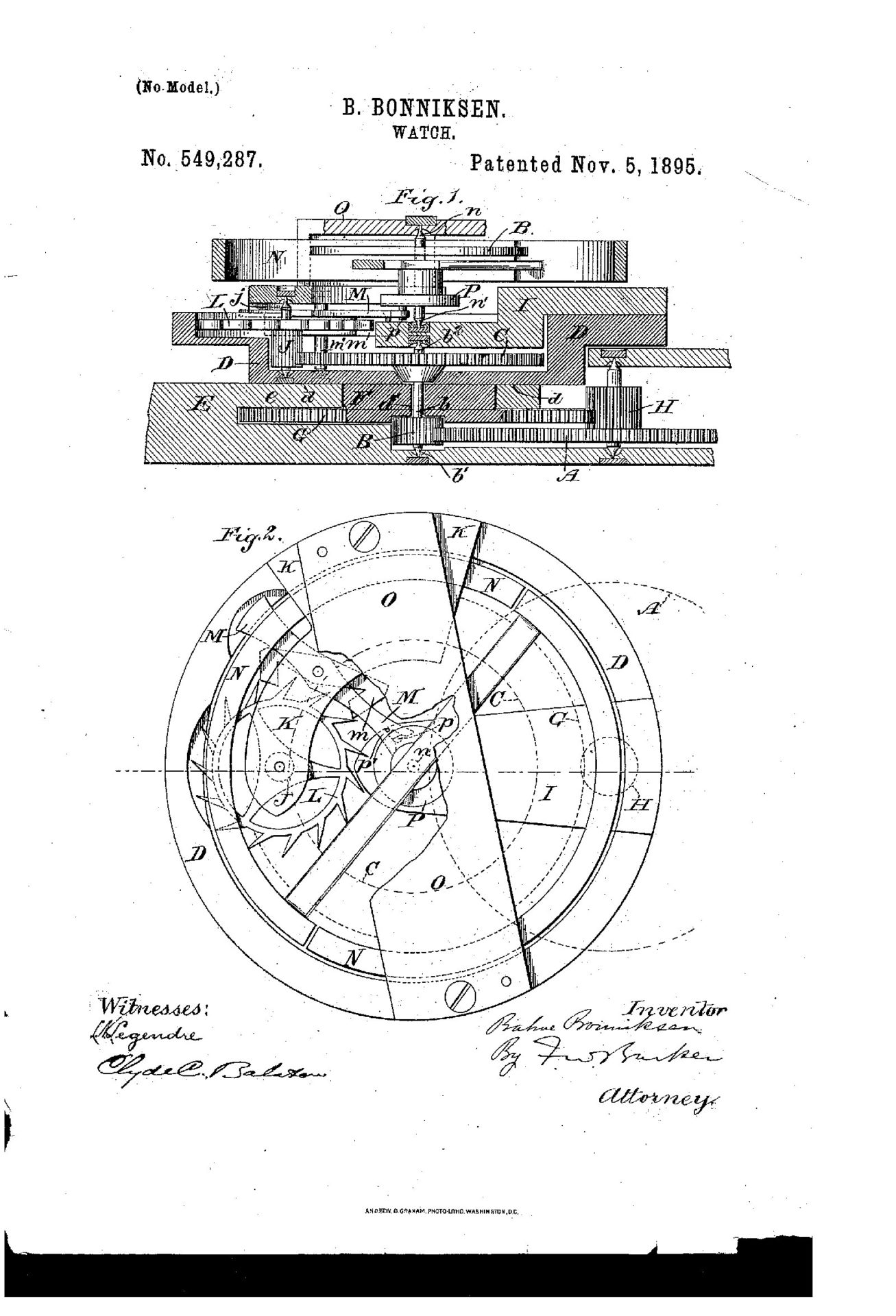
The karrusel diagram from Bonniksen’s 1894 patent
From a technical standpoint, the most important distinction between the 2 constructions is using mounted gears. The tourbillon is usually fitted over a big, mounted fourth wheel. Because the cage is powered by the third gear, the escape pinion runs alongside the mounted gear, which powers the escapement and stability.
Then again, the karrusel employs no mounted gears in any way, as a substitute the cage is powered by the third wheel’s pinion and the third wheel individually powers the fourth pinion.
The result’s that the cage and fourth wheel spin independently in the identical path and across the identical axis, however at decidedly totally different charges, because the fourth wheel has to show quicker to energy the escape wheel. Resulting from this association, the stability normally needs to be offset from the gyration axis as a way to accommodate the escapement.
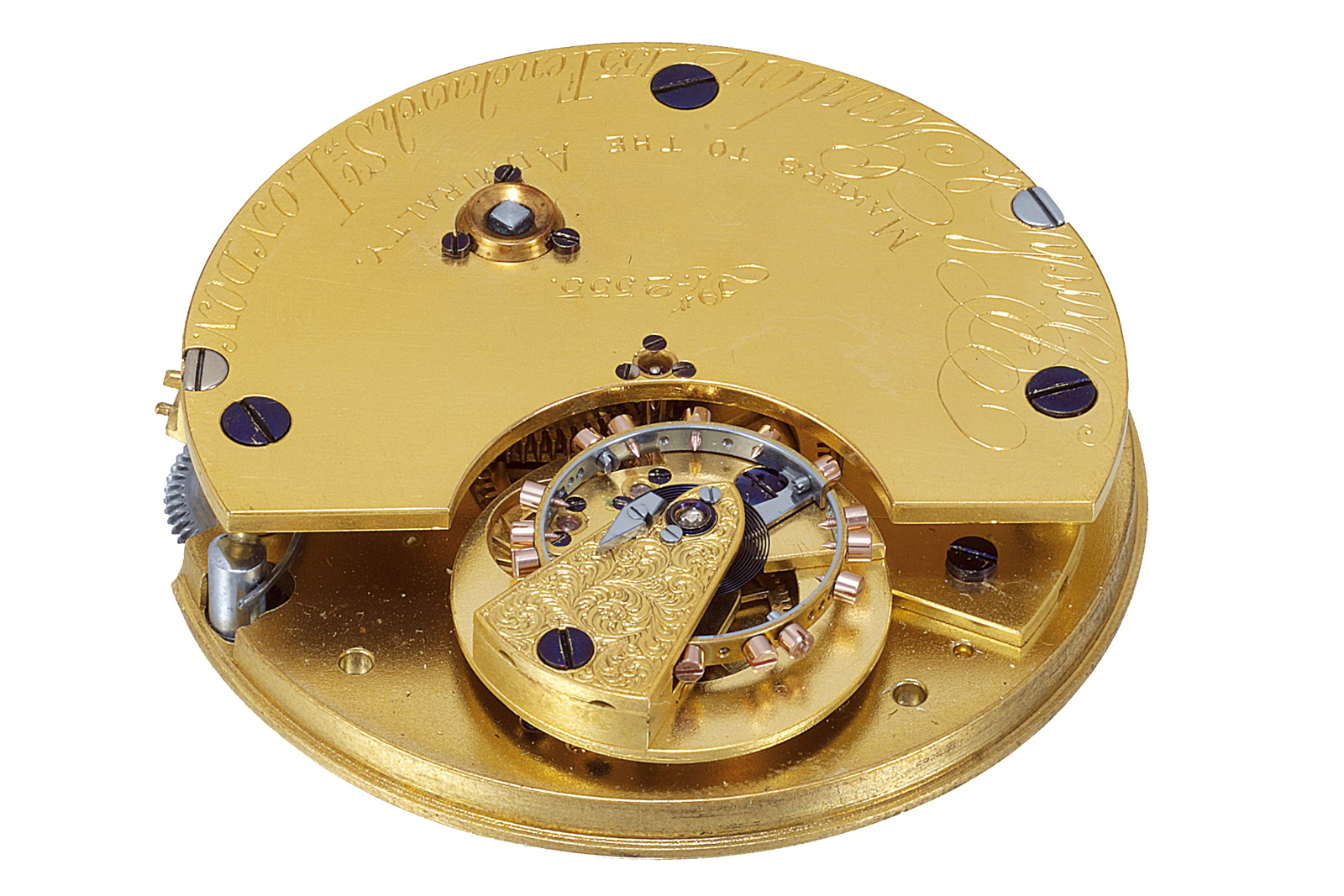
Bonniksen-stye karrusel motion, signed “Birch & Gaydon, Clockmakers in London”. Picture – Antiquorum
Nonetheless, the place of the stability relative to the axis of rotation will not be a dependable marker of both development, as an offset stability doesn’t essentially imply the development is a karrusel. The one definitive side for differentiating one from the opposite is the presence of a set gear of any form: a development incorporating such a gear (or ring gear) in the primary plate is a tourbillon, and any development that doesn’t function any mounted gearing components is a karrusel.
This conclusion brings the dialogue again to the Freak. On the sight of the noticeably off-centre stability, one is likely to be tempted to label it a karrusel. However referring again to the essential working rules of the Freak, we discover that the motion depends on a set inside ring gear to set the escapement in movement, which is assembled on a platform powered by a single pinion S. Thus the Freak is definitely a tourbillon, albeit one in every of a particular breed.
A story of two escapements
The Freak was famously the primary timepiece to utilize silicon elements within the motion. The preliminary designs from Ms Forestier-Kasapi didn’t function nor require any silicon elements, and the structure of the Freak itself doesn’t require any silicon elements. Curiously, the unique patent drawings for the Freak counsel a traditional Swiss lever escapement.
What prompted Ulysse Nardin to develop and make use of this sudden materials was Dr. Oechslin’s need to implement a brand new escapement. The inventor had already persuaded Schnyder to put in a brand new escapement of his personal conception into some prototypes, apparently assembly with a lot resistance.
This occurred in the course of the interval when Omega was investing giant sums of cash into industrialising the Daniels Co-Axial, which it solely achieved in 1999, proving that bringing a novel escapement to market was certainly a dangerous gamble.
Dr. Oechslin was finally granted his want in the course of the late levels of the Freak’s growth, when he was allowed to implement his experimental double wheel escapement within the equally experimental Freak motion. Extra considerably, the Freak’s experiment with a brand new escapement kickstarted using silicon in watchmaking.
The Twin Direct Escapement
Immediately harking back to the Breguet’s ecchapement naturel, the Twin Direct Escapement depends on two mirrored escape wheels, a small detaining lever and compound curler, full with impulse pallets. And in an absolute first, the escapement was manufactured from silicium, a type of silicon lined in a tough oxide layer.
Dr. Oechslin recounts he wasn’t conscious of Breguet’s design on the time he devised the Twin Direct as he had restricted information with historic works. As an alternative he developed the escapement as a result of the usefulness of this association appeared plainly logical to him. Certainly, his thought differs in a some methods from Breguet’s, because the latter used pillars on his twin geared wheels to impart impulse, whereas the Twin Direct employs completely flat escape wheels.
Sadly, the escapement didn’t show very dependable in apply, many house owners having reported it to sometimes malfunction or freeze. That stemmed partially from the truth that the Twin Direct was trialled in a wall clock, and its use in a wristwatch proved problematic. In consequence, most first-series Freaks had their escape wheels changed with an up to date model throughout service. Only a few examples nonetheless retain the unique Twin Direct Escapement wheels.
Regardless of its novelty on the time, there have been good causes silicium was employed within the Freak. First was a matter of the fabric’s hardness. An escapement is by design fast paced, and its motion being correspondingly violent. As such, its elements should be exhausting sufficient to retain a exact form over time.
The subsequent motive has to do with weight. One of many mirrored escape wheels is dragged alongside by its counterpart, which means losses of effectivity attributable to inertia, because the mainspring has to speed up not one, however two escape wheels. Lastly, the tight tolerances required demanded a producing course of that might persistently make small and exact elements.
After unsuccessful trials with brass and aluminium wheels, silicium was prompt. Advantageously, silicium has a floor hardness of about 1,100 Vickers, nearly 10 instances that of brass, and a density of two.33 g/cm³, lower than a 3rd the density of brass.
Furthermore, silicium elements are handy produced by way of DRIE, a producing course of that enables for very exact flat elements with good tolerances on a big scale. In brief, silicium made the Twin Direct Escapement possible.
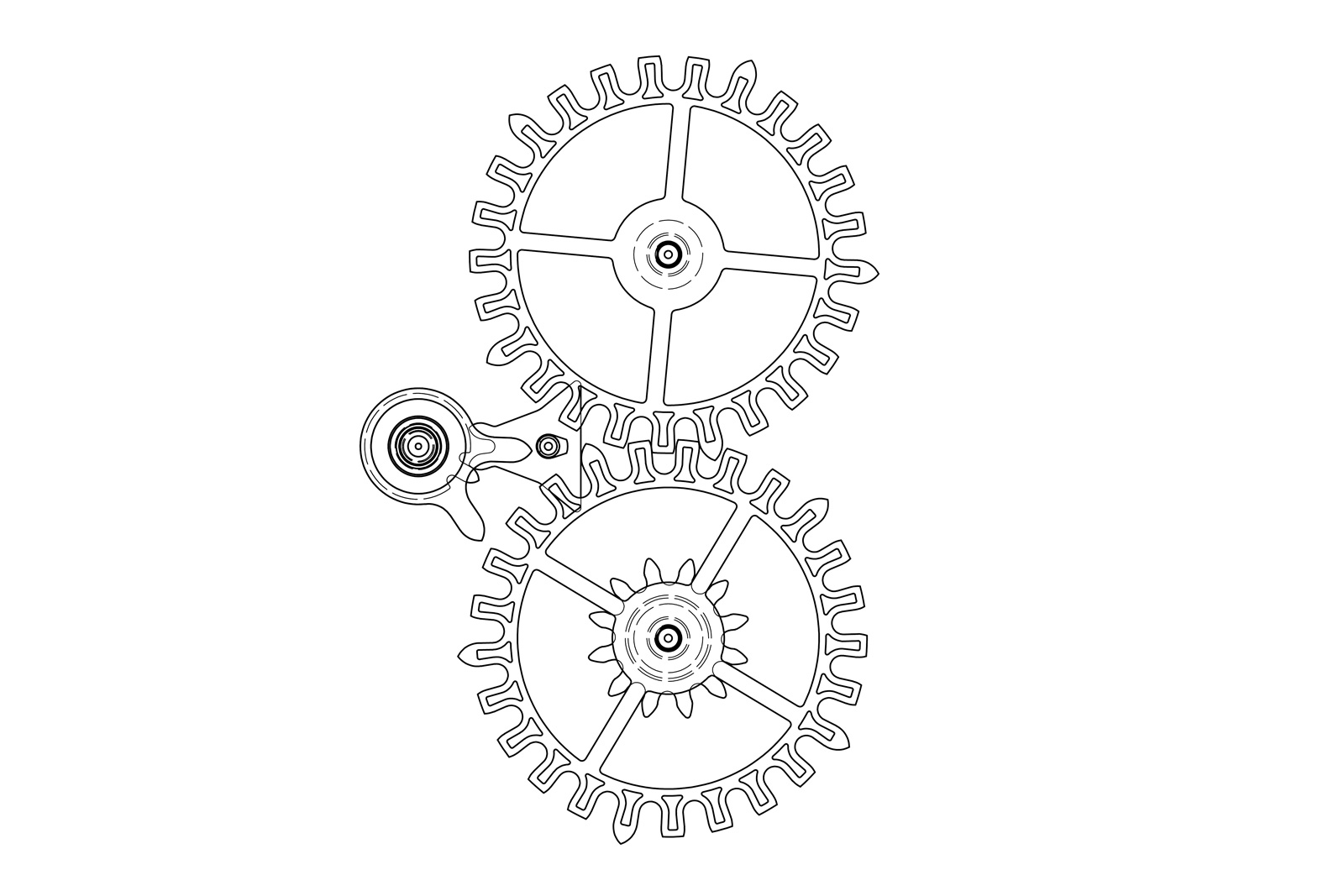
A drawing of the Twin Direct Escapement – Ulysse Nardin
Extracted from patent EP1041459B1 for the Twin Direct Escapement, fig. a reveals the escapement in its equilibrium place. We are able to discover the next predominant constituents: the 2 escape wheels 6 and 7, the lever- platform 21 and the blended curler 1. The escapement is layered as follows: the purple-hued elements are on the identical, decrease layer, whereas the red-hued elements have interaction on a superior degree to the primary.
The 2 escape wheels every function 25 tooth, however in two sorts of tooth profiles, particularly varieties 13 and 15. There are 5 13-type tooth and twenty 15-type tooth on every wheel.
The lengthy tooth are spaced at intervals of 72° (360° divided by the 5 prongs). The 15 kind tooth look as if a big half their addendums was minimize off from the preliminary cycloidal form of tooth kind 13. The addendum is the portion of a gear tooth discovered above the pitch circle. The severed tooth are nonetheless match to calmly have interaction with one other gear. Tweaked on this vogue, the flat gear develops a form of secondary airplane of engagement inside its predominant airplane. It’s clear that tooth 13 attain a bit additional than the shorter tooth 15, to allow them to have interaction with a pair of impulse pallets 17 – 18.
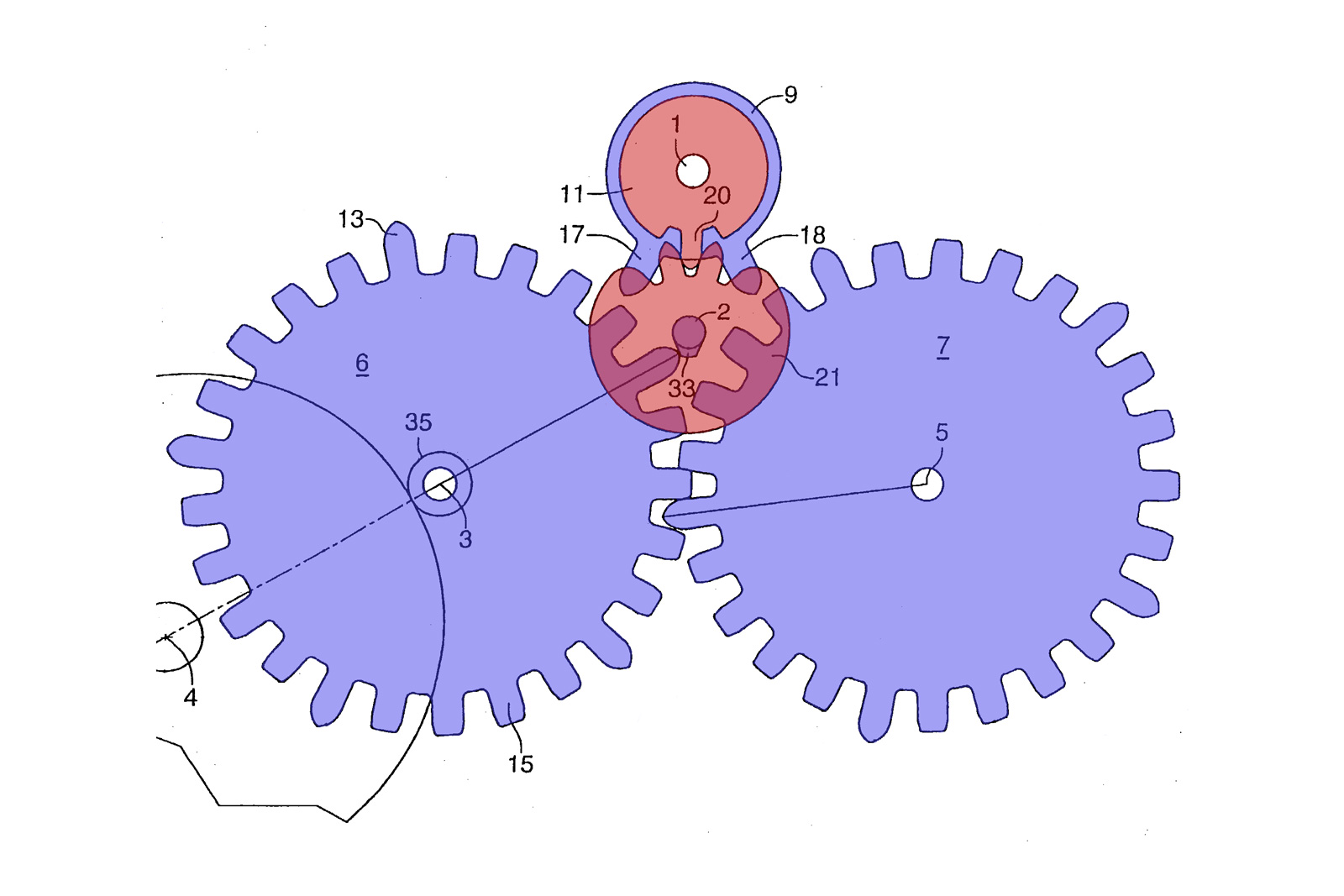
Fig. a
Whereas Breguet opted for 2 cut up layers – a decrease layer for meshing and an higher one for the precise parting of impulse – Dr. Oechslin introduced down the thickness (and subsequently the load and inertia) of his escapement by putting off single-layered wheels. The impulse pallets 17 and 18 belong to the decrease platform 9 of the curler 1. These two pallets are very a lot in contrast to their typical counterparts. They don’t have the same old sharp, rectangular minimize form of conventional stones, nor are they constructed from ruby. Part 9 is virtually a gear with solely two tooth, conveniently organized to function impulse pallets. Fitted co-axially with 9 is the security curler 11, full with tooth 20.
Mentioned tooth behaves like a curler pin, mating with the 2 tooth of platform 21. Platform 21 serves as a form of locking lever by way of its stud-like appendage 33. Fitted to the platform’s axle 2 and on the identical degree with the escape wheels, rocker 33 is designed to have interaction with the lengthy tooth 13 of mentioned wheels.
As talked about, fig. 1 displays the system in its equilibrium state. Linked to pinion 35 of escape wheel 6 is one other gear 4, belonging to the going prepare. If the barrel is wound, it will transmit energy by means of the prepare to the escapement. Underneath the motion of substances 4, driving wheel 6 would flip counterclockwise, entertaining wheel 7 in a clockwise movement of equal angular velocity (attributable to their 1:1 transmission ratio).
In fig. a the escape wheels seem like in an arbitrary place. No matter their beginning place, the 2 wheels don’t enter engagement with the locking rocker 33, because the latter is positioned neutrally by the idle stability wheel.
Ultimately, coerced by the mainspring’s torque, the 2 escape wheels begin turning. Throughout their acceleration, both of them is certain to have interaction impulse curler 9 by means of their respective lengthy tooth 13. In our case a tooth (transversed by a line) of wheel 6 is about to fall into pallet 17, thus disturbing equilibrium and initiating oscillation.
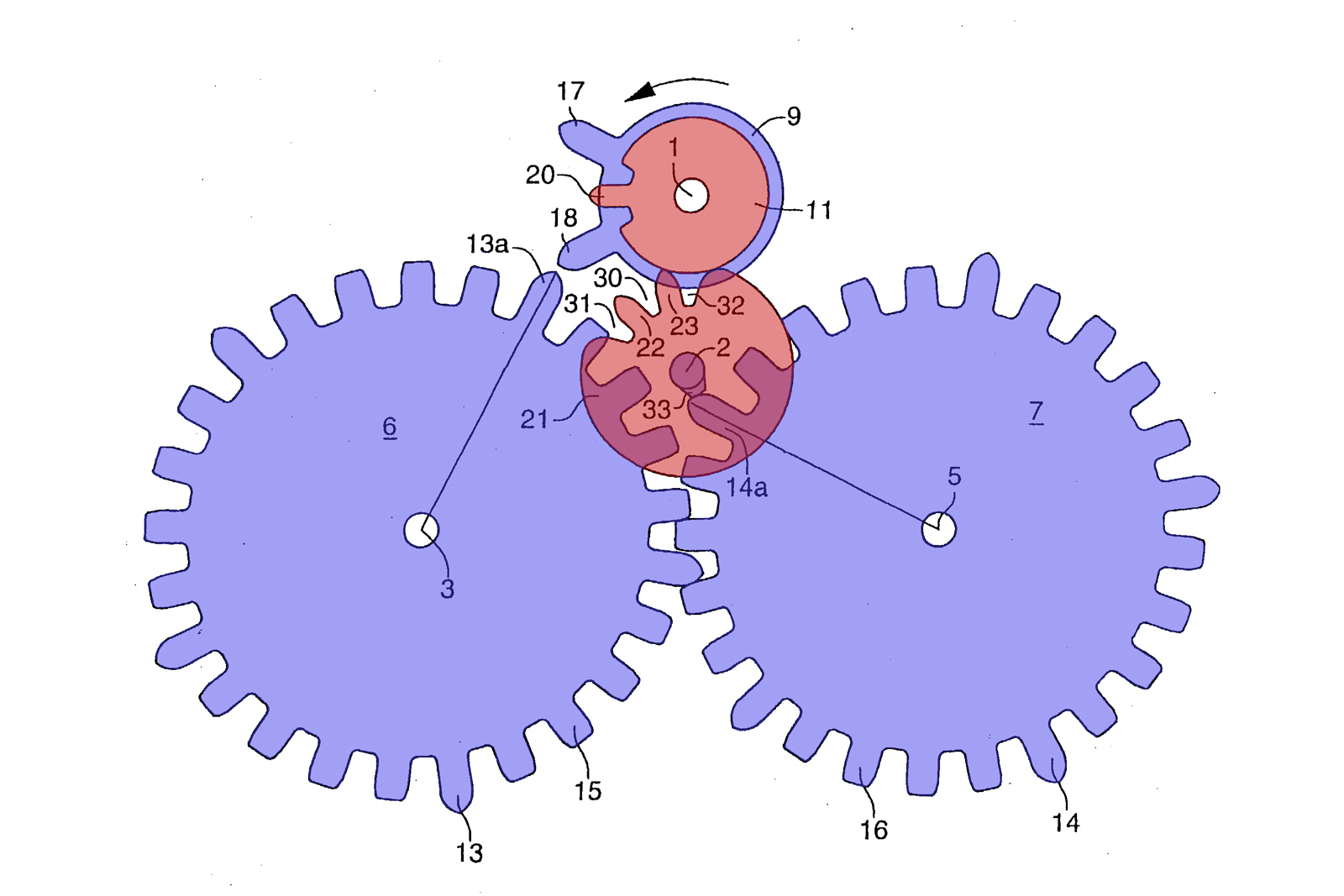
Fig. b
Fig. b reveals the identical system after the impulse was parted. The marked tooth 13a has noticeably superior to a brand new place. In line with the path arrow, the stability has acquired the required impulse and has travelled its supplementary arc, and is now retuning in the direction of its preliminary place beneath the restoring power of the hairspring.
The 2 related escape wheels are locked by the rocker 33, which acts on tooth 14a of wheel 7. The locking is secured by the security run between portion 32 of platform and security curler 11. This isn’t totally dissimilar to the motion of the security pin and curler in conventional lever escapements. Whereas the notch 32 rests involved with 11, platform 21 can’t flip, thus guaranteeing locking by means of the detent 33.
Turning counterclockwise, the balance-roller meeting 1 will first come into contact with platform 21 by means of tooth 20. On both sides of mentioned tooth there are two notches that permit tooth 23 and 22 respectively to slot in and have interaction with 20. From that second of engagement begins the unlocking part, intently adopted by the drop.
The impulse, or drop part will be intently noticed in fig. c. The unlocking is full, rocker 33 having moved out of the best way of tooth 14a, permitting wheel 7 to advance. Tooth 14a falls and rolls towards pallet 18, imparting impulse. The curler accelerates counterclockwise, dragging platform 21 clockwise and setting rocker 33 in place to lock tooth 13b of escape wheel 6. Notch 31 settles involved with the security curler 11, guaranteeing safety of locking. The cycle then repeats.
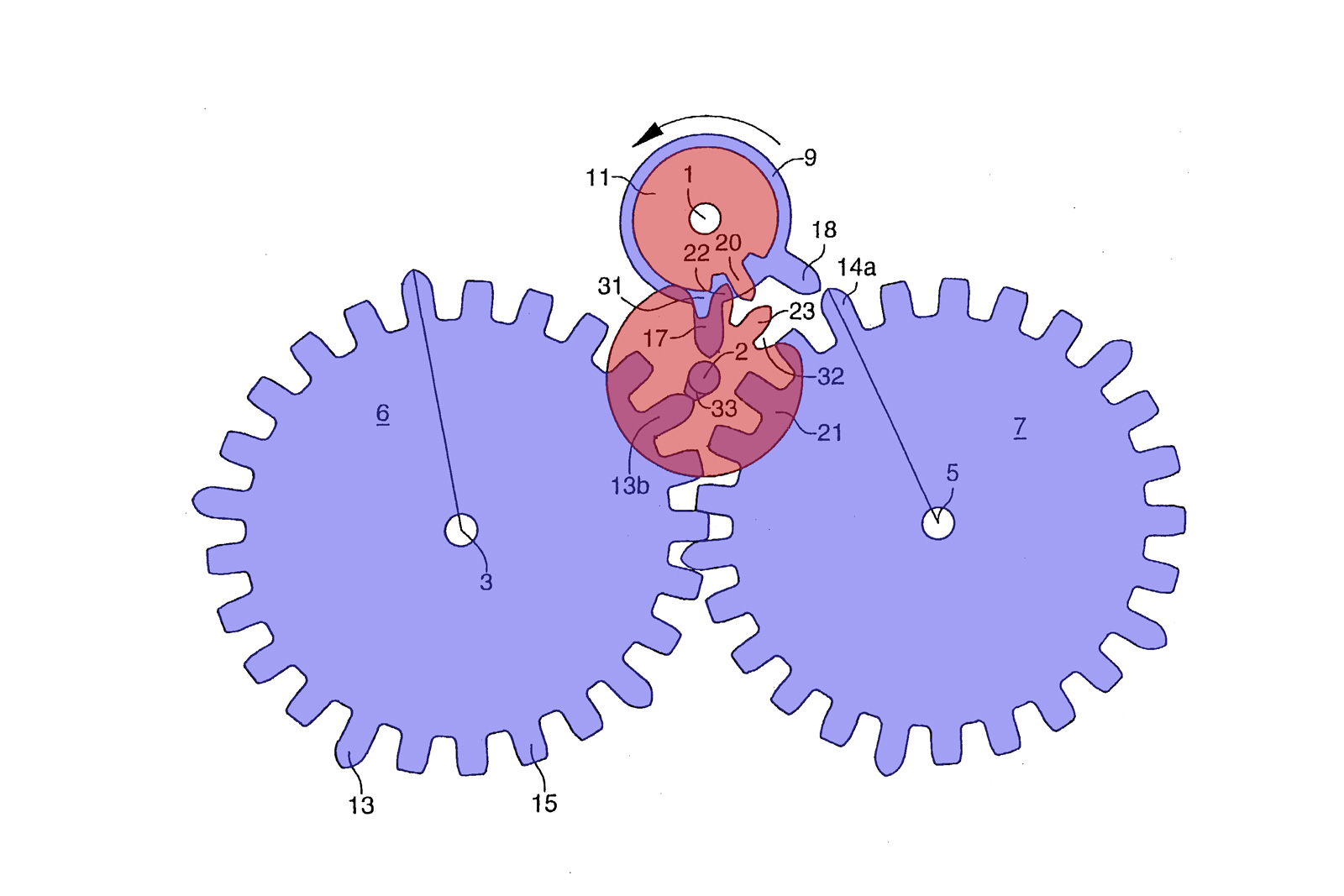
Fig. c
This association incorporates a 1.9:1 escape wheel to curler circumferential ratio and an 1:1 ratio between curler and platform. As plotted from the figures, rocker 33 is displaced a full 35° angle from its centred place throughout locking, which suggests a big, 35° unlocking angle, because of the aforementioned 1:1 ratio.
In the course of the impulse part every wheel travels 36° (half a tooth spacing), of which about 15° of run present energetic impulse. Advised by the 1.9:1 ratio between the escape wheel and curler, the previous travels 28.5° throughout impulse. The locking motion takes place on the identical time with the impulsing, the blocking rocker 33 (together with platform 21) touring one other 35°.
Including all of it up, we get a complete carry angle of 70°, which can seem awfully giant at first, in comparison with the same old 52° angle of carry in Swiss lever escapements. Nonetheless, because the precise impulse part solely takes about 28.5°, and the engagement throughout lock and unlock with the platform causes solely fairly feeble resistance, the disturbances on the stability swing stay minimal.
The next two figures present the Twin Direct because it was applied within the Freak timepieces. The definitive buildings differs barely from the patent figures, particularly within the stability curler and locking lever. The photographs counsel a extra classical association, crafted from an alloy, harking back to established escapement rollers with pin jewel (crimson). The general simplicity of the system is in any other case retained.
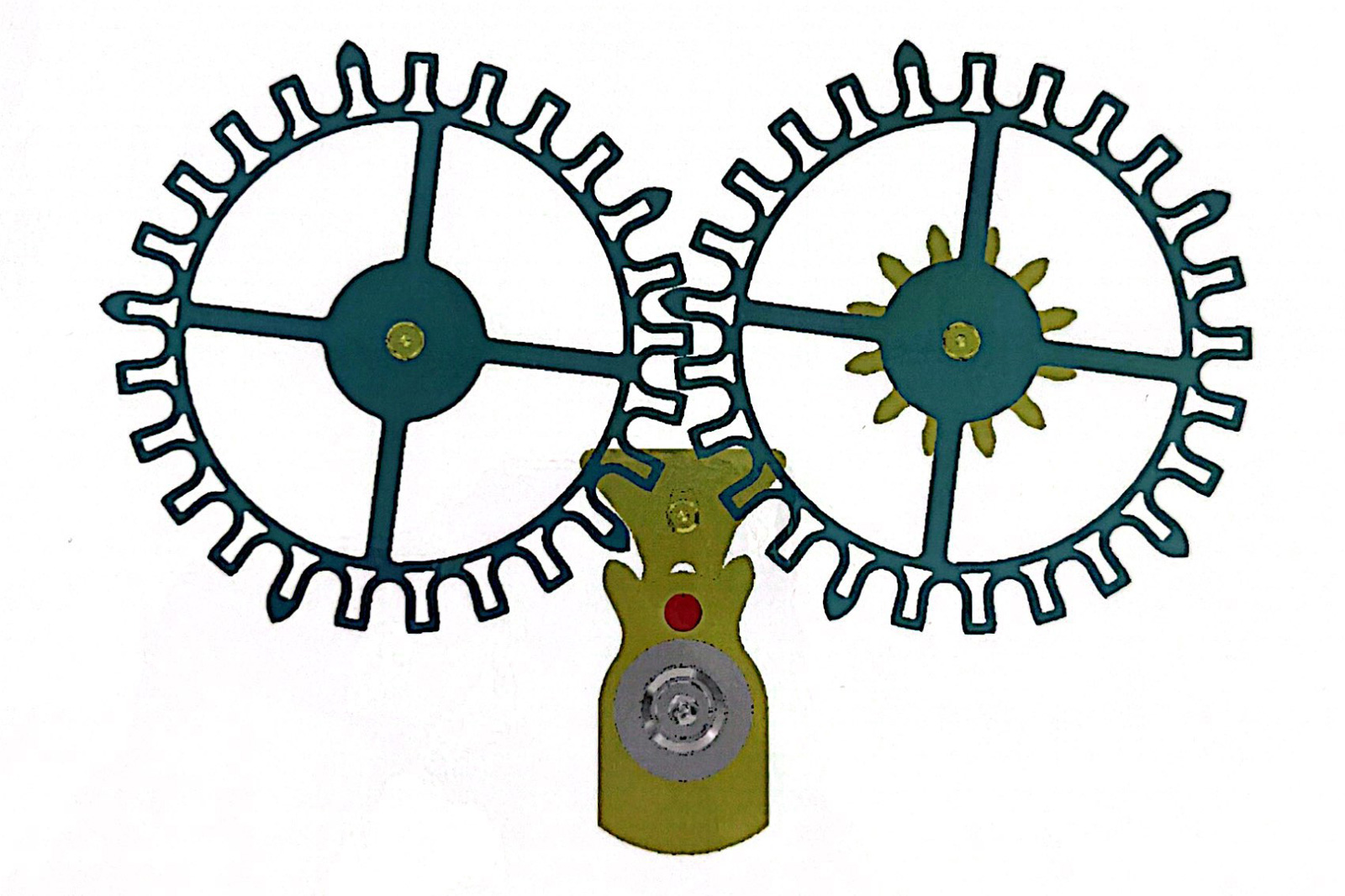
Twin Direct escapement diagram – Ulysse Nardin
The stability within the first sequence Freak beat at 3Hz, that means the stability makes three full oscillations per second, or six vibrations per second. Throughout one vibration every escape wheel advances 36°, for a complete of 72° (or a full tooth spacing) every oscillation. This makes for an angular velocity of three/5 turns per second for the 2 escape wheels. Comparatively, a Swiss lever escape wheel solely turns as soon as each three seconds, nearly twice as gradual as the 2 Twin Direct escape wheels.
The beneficiant spacing between the energetic tooth additionally means they don’t meet with the impulse tooth proper after the unlocking, so there’s a honest portion of “lifeless” journey earlier than the precise drop takes place.
One other particularity of this escapement lies within the absence of draw. The draw angle typically fulfils a security operate. In a Swiss lever for instance, the locking face of the pallet rests on the escape wheel tooth at a sure offset angle, which binds the pallet to the escape tooth. The draw is what presents resistance to unlocking and safety in the course of the giant supplementary arcs. This idea is totally absent from the Twin Direct Escapement, which suggests the locking motion is shallow and unsafe.
Together with the doubtful locking, the interaction between the driving and pushed wheel is one other nice drawback. The foundations of substances engagement are being closely damaged by the totally different tooth lengths, which give for various penetration depths, leading to periodically uneven meshing.
Intrinsic to the development of “pure” escapements, the pushed wheel is beneath no stress when the driving wheel is locked, so it’s allowed a slight flutter. Mix that with the troubled meshing and the result’s extremely unequal and inconsistent impulses. Nonetheless, it’s assumed that the very tight manufacturing clearances in DRIE ought to, in principle, ameliorate the gear interaction to an extent.
As talked about, this primary conceptual escapement carried out poorly within the unique 2001 sequence Freak, which led to most items being retrofitted with a second, extra steady model throughout service. The Twin Direct Escapement was fully reworked, with the second-generation model retaining solely the double wheel structure. We are going to element that within the second a part of the Freak saga.
Again to prime.

